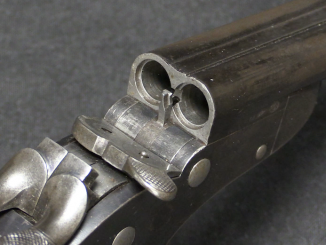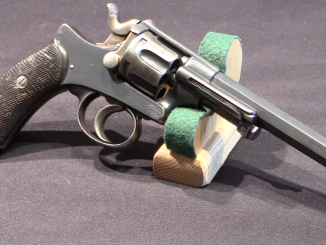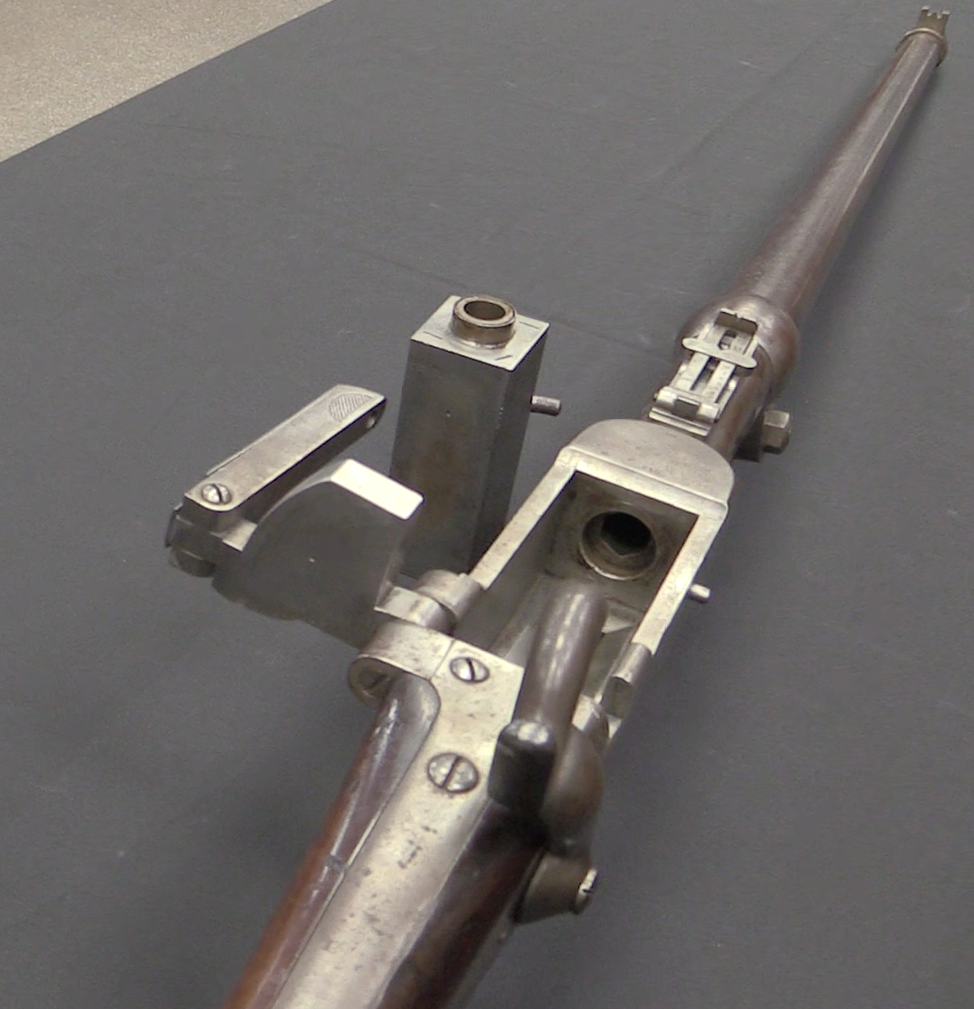The Grande Puissance – High Power – was John Browning’s last firearms design. In fact, he only began the design; it was taken to completion by his protege Dieudonné Saive at FN in Belgium. It was the best military handgun of the time, with a double-stack 13-round magazine capacity, and chambered for the 9x19mm cartridge. Belgium was the First Nation to adopt it for military service, purchasing 1,000 guns for field trials and approving them in 1935 for standard issue as the GP-35.
The Belgian trials guns have a distinctive oval ejection port, which would be changed on production models. They were also fitted with flat board shoulder stocks and tangent sights adjustable up to 500 meters. These features would last until German occupation of the FN factory complex during World War Two, when the guns were simplified under German occupation production.




The problem with stocked pistols with (or without) long range tangent sights is that you can’t see the rear sight because it’s so close to the face. An aperture sight would be better but then, with the stock removed, you find yourself in the same boat, an unusable rear sight.
Heady days of optimistic marksmen
The answer to the rear sight problem would be to make it a rocker design: flip up a notch for pistol use, flip up an aperture for use with the stock. Still nonsense, especially with graduations to — holy Hohokam! — 1,000 meters! But fun to play with, if somebody else will spring for the ammo.
This is the best looking military pistol combined with its potency, hands down. Very tidy, very purposeful in every bit. Mr.Saive (read ‘saiveh’ not ‘saif’) put his talent on display in full. Oh well, that 500m range was a bit optimistic, although the 9mm ball can fly that far.
“500m range was a bit optimistic”
Well, in fact it was requirement of French forces from 1921 which sparked development which would finally end in what we known as Grande Puissance.
There is article: https://www.smallarmsreview.com/display.article.cfm?idarticles=1077 describing that history. In said 1921 France asked for automatic pistol which would:
– fire 9 mm or similar caliber 125 gr at 1184 fps
– sights graduated to 600 meters
– barrel of length 20 cm
– capacity not less than 15
– detachable stock was desirable
– weapon mass less than 1 kg
– have loading indicator
– have cartridge counter
Interestingly as it was developed it was code-named Grand Rendement rather than Grande Puissance meaning high efficiency (? – not sure, can someone better knowing français help – ?).
“Very tidy, very purposeful in every bit.”
And… initially unwanted – note that (relatively small) Belgian forces were first to actually adopt it, rather than France for which changing requirement it was reworked several times (see text in above link), but finally rejected due to probably more political and economic considerations
Actually, even without having this background knowledge, I suspected it came from top. Customer is always right.
Btw, CZ75 was this kind of (all steel) gun, just one generation after. It was intended for military, but did not make it. Even Czech police were happy to get rid of its compact D version. Everyone wants striker fired, plastic frame now. Spoiled sissies.
People who carry much and shoot little tend to like plastic. Personally, I will stick to my CZ75.
Was once tempted to buy a High Power, but they were really expensive for what they were(were running $1,000 USD in the US before they went out of production a number of years ago). Maybe not enough market to justify metal injection molded parts?
At this point, most people’s base of reference is a plastic gun, so everything else does not feel right to them. I think one reason why people stuck to revolvers for so long (despite being one of hardest hand guns to shoot well) was after learning on revolvers, nothing else felt right. At least not until having 15+ shots got their attention.
Back when I introduced some new people to handguns, they tried shooting with their new plastic guns and could not hit the target. Then they tried one of my old steel hammer-fired single-action guns and they hit the bullseye, over and over again. Sure, people can learn to shoot plastic guns really well, but why do things the hard way? Besides the really heavy trigger / magazine safety thing, and a thumb safety that could be better, the High Power got a lot right and would not be that bad of a choice even today.
Not a native speaker, but to my knowledge the best translation and original intent of ‘grand rendement’ would be ‘high yield’.
Native french speaker here. Daweo get it right : ‘Grand Rendement’ is best translated as ‘High Efficiency’ in this case. Although ‘yield’ is the correct translation for ‘rendement’ in other cases, like electric motors.
‘High Power’ does not relate to the ammo but to the double stack magazine allowing a ‘Higher Firepower’ meaning a greater volume of fire before reloading.
Very good, thank you. My mistake lies in reading ‘high yield’ as essentially synonymous with ‘grand puissance’; 13 cartridges would seem a high yield indeed. I fail to grasp the intended meaning of ‘efficiency’ in this context.
500 meter sights. For volley fire against charging spearmen.
Sure, the 500m is optimistic for a single man to hit something. But that’s not the point of putting 500m sights on pistols – or 2000m sights on rifles, either.
On pistols, this goes back to the Artillery Luger, I believe: one person isn’t going to hit an individual target at 250m with one, but a 10-man artillery crew can at least *suppress* someone shooting at them with a rifle from that distance instead of being completely defenseless. And if you’ve already got the sights graduated from 50m-250m in 50m increments, it’s no extra work to make the sight go out to 500m *just in case* the artillery crew needs to suppress someone out at that range.
Same with the 2000m-sights on old service rifles. Not intended for a single rifleman to hit anything at 1000m with iron sights…but a platoon of men with rifles could *suppress* an area 1000m away if they didn’t have machinegun or artillery support. Again, 2000m setting isn’t that useful, even for suppressive fire…but if you already have sights graded in 50m-increments from 100m to 500m, it doesn’t cost any extra to make them go to 1000m or 2000m just in case.
^^ THIS ^^ Exactly.
Volley fire, even from pistols, can act as suppression in dire straits. The whole point being that you do not just sit there and wait for the enemy rifleman to draw a bead and shoot you through a vital organ.
There’s a video up on Youtube showing Jerry Miculek popping a balloon at 1,000 yards using a 9MM revolver.
An extreme example, perhaps, however any reasonably good shot can do real damage with an HP at 100 yards or more with a little practice.
The first time I tried shooting a J frame (17/8 In Barrel)at 100 yards I was able to hit a 12″X12″ gong 2 out of five tries shooting wadcutters.
Gentlemen, it is nice that you invest time in discussing the 500 m sight dead end. Who cares, in view of the FN HP being such an excellent handgun: well balanced in the hand, very precise, very reliable. And the hammer, as in the M1911 for example, shows you immediately whether its cocked or not.
The current striker fire hype was created by the industry because the pistols can made cheaper that way, not because of any real advantages for the user. The first one, Glock Pistole 80, copied the Sauer & Sohn trigger of 1930 (Behördenmodell). Now the bandwagon is in full swing. What is lacking are real improvments beyond marketing nonsense.
Apart from that, we should note that Browing did, as far as I know, never lock the barrel in the ejection port of the slide. Looks like he did not believe in a single unduly small locking surface of possibly questionalble heat treatment?
The FN High Power is not perfect, but ist basic design is sound. Which in my view sets it apart from the fancy products being marketed today.
Well said. I am not against progress, but I too appreciate utility of “cock” fired handguns. And mainly – no polymer; aluminum frame is ok, but aluminum does not like steel in sense of friction.
Actually, while the Glock trigger safety concept came from the Behördenmodell, the actual Glock searage is even older. It’s basically the same as the Austrian Roth-Sauer M1908’s.
So, you had a pistol with a 1908 vintage searage, a 1932 vintage safety, a 1935 vintage locking system (MAS M1935S), firing a 1906 vintage cartridge, using a 1929 vintage magazine design….
….introduced as the Pistol of the Future in 1979.
All I want to know is, whatever happened to those laser “stun guns” we were supposed to have by 1999?
https://vignette.wikia.nocookie.net/moonbasealpha/images/e/e1/MA_Stun_Gun.jpg/revision/latest?cb=20140227162757
cheers
eon
After all these personals points of view, i remember JMB’s photo with a tiny .22 carbine, and the story about the model 1887 shotgun in a gun shop ! I even imagine him smiling under his hat ! ! !
Happy to watch hardwere again , instead of literature…
I noticed that the magazine body appears to be parkerized but the baseplate is blued with a small protruding tab. The follower looks like aluminum. This must be the case for Belgian military contract pistols.
Own and carry a 1972 Hi Power. I have owned plenty of pistols even those plastic one. In my opinion my Hi Power is the best gun I have ever owned.
Thank you great video. Thanks for also going into the Nazi markings.
This is rather a known fact but, would be useful to repeat: At the time when P35 introduced, 9mm Parabellum was a common military round being in use and the “GP” was not choosen to indicate the pistol’s hitting or range species. It was so pronounced because there were no double stack magazine using military pistol at that time and it only referred to its “High Capasity Magazine”… Therefore, “GP” or “HP” means “High Capacity”…
At least we can agree that the Hi-Power had high magazine capacity and a good amount of killing power per shot. I may not have a gun (owing to some gun control laws in my locality banning everything save for non-functioning antiques), but any “get-your-mitts-off-me gun” I would get in case of an outlandish invasion by some New World Order is going to be a steel-framed semi automatic pistol, whether compact or full-sized! I don’t trust the “proper” authorities to save me in a timely manner, given how stupid they get in my county. How stupid? They sent three police cars to accuse my family of dog abuse because a half-deaf spinster claimed she heard our (now deceased) Dalmatian howling in pain when it turned out the “howling” came from a different neighbor’s beagle down the street.
Actually, in the 1920s and ’30s the 9 x 19mm was still pretty much a German “specialty”. Outside of Germany, the most common 9mm cartridge was the 9 x 23mm Bergmann-Bayard, aka 9mm Largo.
The only places the 9 x 19mm was seen other than Germany were countries that had adopted the Parabellum pistol prior to WW1, and had opted for the 9 x 19mm instead of the 7.65 x 21mm Para cartridge. Which basically meant Portugal and the Netherlands (Navy). The Swiss preferred the 7.65mm.
Plus, oddly, the United States, not due to official adoption but rather due to the considerable numbers of P.08s brought back as war booty by American doughboys in 1918. It was these “souvenir” P.08s that were the reason Remington-UMC and Winchester-Western began manufacturing 9 x 19mm (aka “mm Luger”) in the 1920s, purely for domestic commercial sale.
The 9 x 22.5 Steyr was the standard in the former Austro-Hungarian Empire areas. Elsewhere, the most common cartridge for locked-breech as opposed to blowback self-loading pistols was the 7.63 x 25mm Mauser, shortly followed by its “Magnumized” version, the 7.62 x 25mm Tokarev. (You can safely fire 7.63 Mauser in a 7.62 Tokarev-chambered weapon, but not vice-versa.)
It was really WW2, with the advent of 9 x 19mm submachine guns like the MP38/40 and the Sten on both sides, that made the 9 x 19mm the “world standard” that it is today. Because after the war, everybody outside of the Soviet/Red Chinese bloc went to 9 x 19mm SMGS for a lot of military and police purposes, and they also went to pistols that chambered whatever their SMGs used. The 7.62 x 25mm Tokarev became the default pistol round in Soviet/PRC “allies” and “client states” for basically the same reason.
The anomaly was the United States. We stuck with the .45 ACP until the mid 1980s, while our allies, notably NATO, were all using the 9 x 19mm. For reasons of “stopping power theories” that we now know were due to fundamental misunderstandings of basic physics. (At least the 5.7 x 28mm myth didn’t last as long.)
The High Power went on to become at one time the most widely used military handgun on Earth, adopted by 65 countries. But that was mainly due to it being the best handgun around that used the same ammunition as the SMGs everybody was using.
cheers
eon
Just a follow up point
The GP35 was fairly good at surviving the abuse of firing heavy loads intended for SMG
Where certain other contemporary and later pistols were not.
Do you have a detachable stock for a pre-war Belgian 9mm pistol?
I’ve just been reading James Hahn’s autobiography. Hahn owned and ran the John Inglis Company from the mid 30s when it went into receivership through the war into the 50s. He bought and refinanced it specifically because of his concern about the preparedness of the west for war. There’s only this line about the Browning: “Later we received six handmade samples of a nine millimetre automatic pistol, originally designed by a Belgian ordnance company. These were produced by us in large quantities.” No mention of Saive or his painstaking reproduction of plans being received in Toronto. This lends credence to the version that it was a Nationalist Chinese delegation’s visit that prompted Inglis making the Browning, with officers handing over their personal weapons to be used as samples. It’s interesting reading; Hahn was a very busy fellow during the war and after.
I am trying to find out when my GP35 was produced. the serial number is 7174 and is marked on slide, barrel & frame 7174 with all Belgian military proofs on each of them. I am guessing this pistol was manufactured in late 1935 or early 1936. it also has the Belgian military leather holster. can someone verify this date of production on my GP35 for me please. Thanks